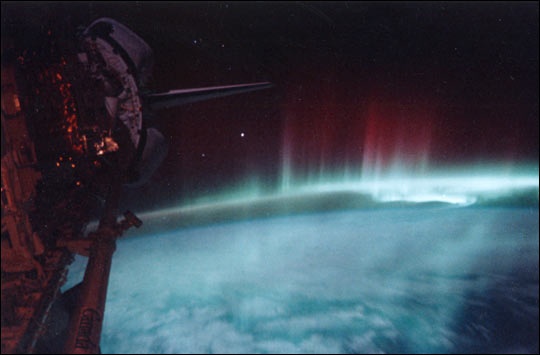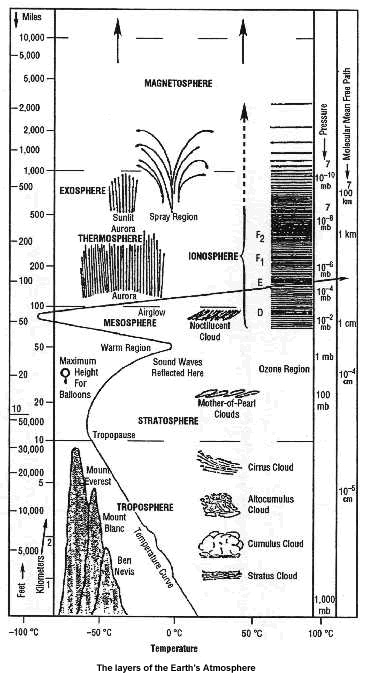…we’ve got to go out to Asteroid HS-5388 and turn it into Space Station E-M3. She has no atmosphere at all, and only about two per cent Earth-surface gravity. We’ve got to play human fly on her for at least six months, no girls to date, no television, no recreation that you don’t devise yourselves, and hard work every day. You’ll get space sick, and so homesick you can taste it, and agoraphobia. If you aren’t careful you’ll get ray-burnt. Your stomach will act up, and you’ll wish to God you’d never enrolled. But if you behave yourself, and listen to the advice of the old spacemen, you’ll come out of it strong and healthy, with a little credit stored up in the bank, and a lot of knowledge and experience that you wouldn’t get in forty years on Earth.
— Robert Heinlein "Misfit"
What’s it like up there? Every 90 minutes, your satellite orbits the Earth. Each orbit passes high over a different geographic coordinate. The atmosphere you encounter is negligible, a residue of trace oxygen and other atoms with no real pressure to sustain you, just enough pressure to cause drag and (in months or years) reduce your orbit and cause reentry.
The Sun bathes you in heat and ultraviolet (UV) and X-rays and all the other wavelengths of light. When in sunlight, your satellite heats up, perhaps uncontrollably. For half of each orbit, the Earth blocks the Sun and your satellite radiates out into that cold 3-degrees above absolute zero ambient temperature of space.
High energy particles (protons and electrons) stream from the Sun and interact with the Earth’s magnetic field, creating beautiful aurora and potentially frying your electronics (see Figure 1-1). Very rarely, you might encounter space dust or tiny bits of orbital debris.
All this assumes you survived the rocket launch.
Space is a harsh and unforgiving environment. It is harsh because it has no pressure or outside forces to provide structure, just vacuum. There is no air or liquid to conduct heat or buffer temperatures. It is filled with electromagnetic and particle radiation. Worse, if something breaks, you can’t pop over to fix it. You get one shot and have to make that one shot work. Fortunately, through testing, you can practice your shots before the real event.
Space:
- is airless
- yet has atmospheric drag
- is hot and cold
- is insulating
- has electric and magnetic fields (as well as field hot spots like the South Atlantic Anomaly, where the Van Allen belts dip close to Earth)
- is influenced by solar weather
- lets the spacecraft jitter in attitude, bounce, and overall momentum
- requires orbital maneuvering rather than line-of-sight travel
Space is the highest of the three final frontiers (see Frontiers). It is an airless, inhospitable place where your three biggest problems are a lack of air, extremes of hot and cold, and a surplus of electromagnetic energy. It also takes an enormous amount of fuel to get up there. To succeed in space, you must be lightweight, pack small, and be tough. This book tells you how to test whether your satellite will survive low earth orbit (LEO).
The air pressure in LEO is effectively nil. There’s just enough air to provide atmospheric drag to de-orbit your satellite, but not nearly enough air to provide any structural or navigational assistance.
In space, there is no thermal blanket of air or water to help you retain or dissipate heat. Therefore, when the sun shines, you heat up—rapidly. When you are in darkness, you cool through radiative heat, and can keep cooling (in theory) until you reach 3K, or about -270 C or -454 F (for this work we’ll be using Celsius).
To this environment, we add a fourth challenge—the rumbles required to get there. A rocket launch will apply intense g-forces, where acceleration of the rocket presses your payload as if it were feeling strong gravity. The rocket will vibrate and shake at different rates as it goes through different stages. Finally you get a thump as your satellite is ejected from the final stage. Here is where your satellite may drop a few inches very quickly. In any part of this, there may be mechanical mishaps as well.
Looking at what can go wrong with a rocket launch, we’re hard put to find something that can’t go awry. Here’s a short list of just some of the things that can go wrong during launch and early orbit checkout. You might have a launch vehicle problem and get into an improper orbit. Or, the forces of launch can damage your satellite from acoustics, g-forces, vibration, changes in atmospheric pressure, temperature changes, or outgassing. You may reach orbit but not have the right facing or spacecraft attitude (not an emotion, just means facing and orientation), making it difficult to communicate or misaligning your solar panels to the sun so you can’t get power. Your satellite may underperform or overperform. You may miss detecting time-critical anomalies (satellite bits that go wrong) or situations (events that go wrong). Your team can make a hasty or incorrect decision. Your operating procedures may be incorrect. Your hardware or software may have bugs. (Thanks to Squibb, Boden and Larson, Cost-Effective Space Mission Operations, 2nd edition, pg 304, for this list.)
If all this sounds pessimistic, remember this is the book on testing. Your plan is to perform reasonable tests to mimic the conditions the satellite will face when you deploy for real. Good testing reduces risk, though you can never eliminate it. In fact, you need to be sure you don’t get overzealous with your testing and actually break something for no other reason than testing it.
For example, if you want to test whether your car door is closing properly, you may want to slam it closed two or three times. But slamming it fifty times won’t give you more information—and may break something that was working perfectly.
So our mantra is to devise a thorough test plan, carry it out in a reasonable fashion, analyze your test data, then stop. Each of those four steps is important.
How high is space, how far can you fall with a parachute, where do Low Earth Orbit (LEO) satellites reside, and where does the hard radiation from the sun get nasty? Gathered for the first time in one place is our High Altitude Explorer’s Guide (Figure 1-2).
A typical airplane cruises at 9 km (6 miles) up, around 30,000 feet. Military jets (from the SR-71 onward to modern planes) can hit over 30 km (19 miles) up, over 100,000 feet. You can parachute from that height. In 1960, Joseph Kittinger set the record at 31.3 km (19.5 miles), or 102,800 feet. Felix Baumgartner is planning to use a rocket to freefall from 36 km (over 22 miles)—an 118,000 feet fall—some time before 2015.
But those aren’t space (Chapter 2). In the US, “space” begins at 80.4 km (50 miles), or 264,000 feet. General international consensus sets a similar limit for the start of space as 100 km (62 miles), or 380,000 feet.
“Low Earth Orbit” (LEO), where many satellites live, goes from 160 km (100 miles, 525,000 feet) to 2,000 km (1,240 miles, 6.5 million feet). My own Project Calliope picosatellite will be 230 km up (143 miles, 755,000 feet). The International Space Station (ISS) cruises higher up, from 278 km (173 miles, 912,000 feet) to 460 km (286 miles, 1.5 million feet).
Starting above the space limit but a bit before LEO, the inner Van Allen Belts, which magnetically shield the Earth’s surface from high energy particles, extend from 100 km (62 miles, 33,000 feet) up to 10,000 km (6,200 miles, 3.3 million feet).
Finally, geostationary orbits are at 35,786 km (22,236 miles, 117.5 million feet). These geosynchronous orbits, lined up above the Earth’s equator, have an orbital period equal to one day, so they hover over the same spot of the Earth.
Together, that’s “space”, with an emphasis in this book on LEO. We’ll walk through several bits of homemade gear to tackle these tests. For a vacuum test, you can make a simple chamber using a pressure cooker and an automotive brake vacuum pump. For thermal vacuum, you need to add an IR heat source. For vibration and shake testing, you can modify power tools to do simple test scenarios. G-forces can be tested primitively using the centrifugal force provided by you swinging a rope, or with more technical elan using a power drill and a long pair of swing arms. As for the drop test, that’s both the simplest and most nerve-wracking, as you simply have to be willing to drop your work. But first, a deeper look at space. Let’s look at the hard numbers for where we’ll be sending our picosatellite.
Get Surviving Orbit the DIY Way now with the O’Reilly learning platform.
O’Reilly members experience books, live events, courses curated by job role, and more from O’Reilly and nearly 200 top publishers.



